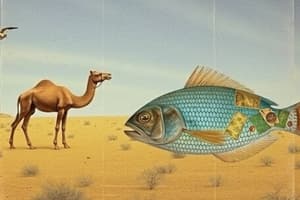Podcast
Questions and Answers
Which of the following is NOT a type of adaptation?
Which of the following is NOT a type of adaptation?
- Structural adaptation
- Physiological adaptation
- Biochemical adaptation (correct)
- Behavioral adaptation
What is camouflage an example of?
What is camouflage an example of?
- Structural adaptation (correct)
- Environmental adaptation
- Physiological adaptation
- Behavioral adaptation
What is adaptation primarily defined as?
What is adaptation primarily defined as?
- A learned behavior from other organisms
- A hereditary characteristic that improves survival (correct)
- An immediate physiological response to stress
- A temporary change in an organism's behavior
Which of the following behaviors represents a behavioral adaptation?
Which of the following behaviors represents a behavioral adaptation?
What function do physiological adaptations serve?
What function do physiological adaptations serve?
What is mimicry in terms of behavioral adaptations?
What is mimicry in terms of behavioral adaptations?
Which of these is an example of a structural adaptation?
Which of these is an example of a structural adaptation?
Which statement best describes hibernation?
Which statement best describes hibernation?
Flashcards are hidden until you start studying
Study Notes
Adaptation is a fundamental concept in biology that describes the process through which organisms develop traits that improve their ability to cope with environmental changes. These traits, which can be physical, behavioral, or physiological, arise from genetic variations that occur over time. As environmental pressures such as climate change, food availability, and predator-prey relationships shift, organisms that possess advantageous traits are more likely to survive, reproduce, and pass these characteristics on to their offspring. This process of natural selection leads to the gradual evolution of species, enhancing their overall resilience and promoting biodiversity within ecosystems. By understanding adaptation, we can better appreciate the intricate relationships between species and their environments, along with the mechanisms that drive evolution. Overview
- Adaptation refers to hereditary characteristics that enhance an organism's ability to survive and reproduce in changing environments.
- Over generations, successful adaptations are passed down, increasing the likelihood of species survival.
Importance of Adaptation
- Secures essential resources: food, water, and nutrients.
- Facilitates acquiring air, warmth, and shelter.
- Enables coping with varying physical conditions like temperature and light.
- Enhances defense mechanisms against predators.
- Supports reproductive success and care of offspring.
- Allows responsiveness to environmental changes.
Types of Adaptation
- Structural Adaptations: Physical features enabling survival.
- Functional (Physiological) Adaptations: Internal processes that facilitate chemical reactions.
- Behavioral Adaptations: Actions organisms perform to thrive in their habitats.
Structural Adaptation
- Defined as physical traits that help with survival.
- Key aspects include skin color, body shape, and covering.
- Examples:
- Camouflage: Helps organisms blend into their surroundings; seen in chameleons and stick bugs.
Physiological Adaptation
- Involves biological systems that allow for various biochemical reactions.
- Examples:
- Production of venom for defense or hunting.
- Secretion of slime for movement or protection.
- Phototropism: Growth responses to light, aiding in plant survival.
Behavioral Adaptation
- Involves specific behaviors aiding survival in the environment.
- Key behaviors include:
- Mimicry: One species resembles another for protection.
- Hibernation: Inactivity and metabolic depression in response to cold.
- Mating: Pairing for reproductive purposes.
- Parenting practices: Specific behaviors related to offspring care.
- Nest building: Driven by instincts to safeguard young.
- Migration: Seasonal movement to new locations for resources.
Examples of Behavioral Adaptation
- Mimicry provides a survival advantage through resemblance to other species.
- Hibernation aids in survival during unfavorable climates.
- Mating strategies ensure the continuation of species.
- Parenting practices differ among species affecting offspring survival.
- Nest building is a biological drive to protect young.
- Migration patterns can lead to better resource availability and survival rates.
Studying That Suits You
Use AI to generate personalized quizzes and flashcards to suit your learning preferences.




